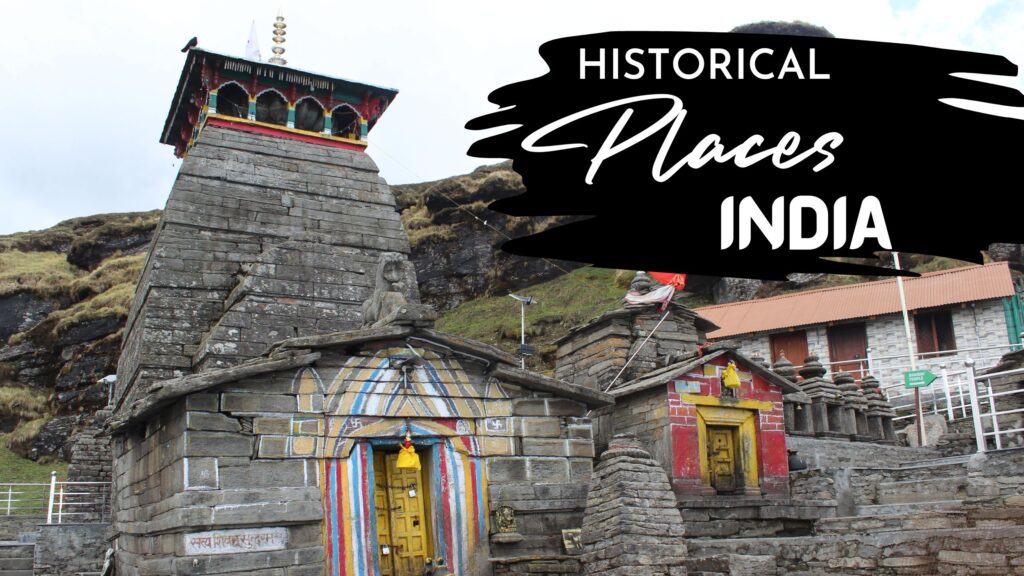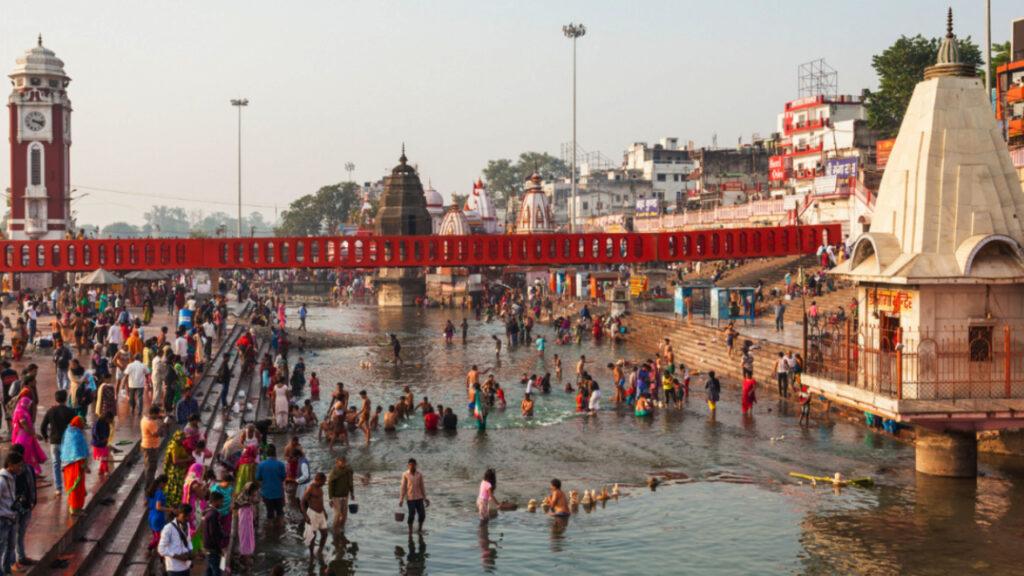India is a best treasure trove of history and culture, with endless ancient websites that provide a glimpse into its impressive beyond. From historical forts and palaces to ancient temples and metropolis ruins, India has a diverse array of historic locations well worth exploring. Locations show off the top notch architectural brilliance and offer perceptions of its cultural, social, and spiritual history. Delve into 20 Best Historical places in India, providing special descriptions and highlighting the specific capabilities of each place. By the end, you’ll have a deeper knowledge of these landmarks with a list of historical places in India and feel stimulated to go for a visit.
20 Best Historical Places in India to Visit
Taj Mahal, Agra
One of India’s most famous historical attractions is the Taj Mahal, which is situated in Agra. One of the Seven Wonders of the World and a symbol of love, the Taj Mahal was built by the Mughal Emperor Shah Jahan in honor of his wife, Mumtaz Mahal. White Marble Mahal is renowned for its exquisite gardens, intricate marble inlay work, and intricate architecture.
Best times to see the Taj Mahal’s magnificence are at sunrise or sunset, when the light gives the marble building a mysterious sheen. Mumtaz Mahal and Shah Jahan’s recollections are beautifully embellished with priceless stones inside the Taj Mahal, showcasing the artistry of the time. Symmetrical design of the surrounding gardens and the reflected Yamuna River lend an air of ethereal beauty to the monument.
How to Book Taj Mahal Tickets Online?
Red Fort, Delhi
Delhi‘s Red Fort is a magnificent example of Mughal architecture and a UNESCO World Heritage Site. Constructed during the 17th century by Emperor Shah Jahan, the main residence of the Mughal rulers was used for about 200 years. Fort is well-known for its exquisite Diwan-i-Khas and Diwan-i-Am, as well as its gorgeous red sandstone walls. Nighttime music and light show is a must-see, telling the story of the fort’s records.
Rang Mahal, which was converted into the residence of the emperor’s ladies and mistresses, and the Moti Masjid, a modest but exquisite mosque built by Aurangzeb, are two of the Fort’s many unique features. Not only is the Red Fort a historical site, but it also represents India sovereignty, as it hosts the yearly Independence Day celebrations where the high minister hoists the national flag and addresses the nation.
Hampi, Karnataka
In the fourteenth century, the Vijayanagara Empire’s capital was Hampi, now a UNESCO World Heritage Site in Karnataka. Spectacular gateways, royal architecture, and temples of this ancient city are well-known. Lotus Mahal, the Vittala Temple, and the Virupaksha Temple are among the main attractions.
Tungabhadra River and the boulder-strewn terrain both contribute to the unique appeal of Hampi. One of the oldest continuously operating temples in India, the Virupaksha Temple is devoted to Lord Shiva and dates back to the 7th century. Vittala Temple is well-known for its musical pillars, which when struck, make amazing melodies, and its stone chariot. Discovering the remnants of Hampi offers an enthralling perspective on the magnificence and social standing of the Vijayanagara Empire, rendering it a must-visit for record enthusiasts and structure fanatics alike.
Ajanta and Ellora Caves, Maharashtra
Maharashtra‘s Ajanta and Ellora Caves are stunning illustrations of prehistoric rock formations. Renowned for their exquisite Buddhist sculptures and murals, the Ajanta Caves date back to the 2nd century. Hindu, Buddhist, and Jain temples and monasteries can be seen in the Ellora Caves, which were built during the sixth and tenth centuries. Particularly notable is the Kailash Temple in Ellora, which is devoted to Lord Shiva.
This rock-carved monolithic temple is a marvel of engineering that demonstrates the inventiveness and technological prowess of ancient India. With their depictions of Buddha’s lives and different Jataka recollections, the Ajanta Caves offer a fascinating look into the rich spiritual and cultural heritage of ancient India. Exploring these caves is like taking a trip through time, providing a profound appreciation for the creative and spiritual contributions of India’s beyond civilisations.
Khajuraho Temples, Madhya Pradesh
Khajuraho Temples in Madhya Pradesh are famed for their beautiful erotic sculptures and elaborate carvings. Built between the tenth and twelfth centuries, these Hindu and Jain temples are a testament to historical India’s architectural and creative excellence. Temples are divided into three categories: Western, Eastern, and Southern, with the Western institution being the most well-known.
Kandariya Mahadeva Temple, committed to Lord Shiva, is the largest and most ornate of the Khajuraho temples. It functions as intricately carved statues of deities, apsaras (celestial dancers), and mythical creatures. Temples’ erotic sculptures, depicting diverse factors of human existence and sexuality, are celebrated for their creative splendor and the sophisticated know-how of human nature. Touring the Khajuraho Temples offers a unique mixture of spirituality, art, and records, making it a charming vacation spot for tourists.
Fatehpur Sikri, Uttar Pradesh
Fatehpur Sikri, located near Agra in Uttar Pradesh, became the capital of the Mughal Empire at some stage in the reign of Emperor Akbar. Properly preserved town is a UNESCO international background web site and is famous for its stunning blend of Hindu, Persian, and Islamic architecture. Key attractions consist of the Buland Darwaza, Diwan-i-Khas, Panch Mahal, and the Tomb of Salim Chishti. Buland Darwaza, a grand gateway built to commemorate Akbar’s victory in Gujarat, is one of the tallest gateways within the international.
Diwan-i-Khas, or hall of personal target market, functions as a completely unique primary pillar with a platform where Akbar held discussions with scholars from numerous religions. Panch Mahal, a 5-story palace, gives panoramic views of the encompassing vicinity. Tomb of Salim Chishti, a respected Sufi saint, is an important pilgrimage site and an image of Akbar’s recognition for unique religions. Journeying Fatehpur Sikri offers a charming perception into the era of leadership and cultural synthesis of Emperor Akbar’s reign.
Amer Fort, Rajasthan
Amer Fort, located near Jaipur in Rajasthan, is a brilliant instance of Rajput architecture. Built in the 16th century by Raja guy Singh, the fort is known for its lovely palaces, ancient gates, and scenic views of Maota Lake. Key points of interest inside the fort encompass the Sheesh Mahal (Palace of Mirrors), Diwan-i-Khas, and the Sukh Niwas.
Sheesh Mahal is especially well-known for its stunning mirror paintings, which create a stunning effect when lit by candlelight. Fort’s architecture blends Hindu and Mughal patterns, reflecting the cultural amalgamation of the time. Elephant trip is also famous there as much as the fort is popular, offering a regal experience that takes you back to the era of Rajput kings and queens. Light and sound display during the night narrates the history of Amer Fort, adding a magical touch to the visit.
Konark Sun Temple, Odisha
Konark Sun Temple in Odisha is a UNESCO global background website and a masterpiece of ancient Indian architecture. Constructed in the thirteenth century by King Narasimhadeva I, the temple is devoted to the sun god Surya. Temple is designed in the form of a big chariot with intricately carved stone wheels, pillars, and partitions depicting various mythological scenes.
24 wheels of the chariot constitute the hours of the day, and the seven horses represent the times of the week. Temple’s wonderful carvings consist of depictions of deities, celestial musicians, dancers, and animals, showcasing the creative brilliance of the craftsmen. Once-a-year Konark Dance pageant, held inside the backdrop of the temple, draws classical dancers from all over the United States, adding to the cultural significance of the site. Journeying to the Konark sun temple is an adventure into the non-secular and artistic background of historical India.
Meenakshi Temple, Tamil Nadu
Meenakshi Temple in Madurai, Tamil Nadu, is a lovely example of Dravidian structure. Dedicated to the goddess Meenakshi and her husband, Lord Shiva, the temple is known for its towering gopurams (gateway towers), difficult carvings, and the lovely corridor of Thousand Pillars. Yearly Meenakshi Thirukalyanam competition attracts heaps of devotees.
Temple complex, spread over 14 acres, includes 14 gopurams, with the southern tower being the tallest. Corridor of the Thousand Pillars, with its intricately carved columns, is a testament to the architectural and artistic excellence of the Dravidian craftsmen. Temple’s vibrant sculptures and artwork depict various mythological stories and legends related to Meenakshi and Shiva. Bustling markets around the temple offer a glimpse into the nearby lifestyle and traditions, making it a vibrant and spiritually enriching vacation spot.
Qutub Minar, Delhi
Qutub Minar in Delhi is the tallest brick minaret inside the global and a UNESCO global background web page. Built in the twelfth century by Qutub-ud-din Aibak, the minaret stands at a height of seventy-three meters and is decorated with intricate carvings and inscriptions. Encircling Qutub complex includes the Quwwat-ul-Islam Mosque, Alai Darwaza, and the Iron Pillar of Delhi.
Quwwat-ul-Islam Mosque, the first mosque built in India, showcases the fusion of Islamic and Hindu architectural patterns. Iron Pillar, dating back to the 4th century, is famous for its rust-resistant composition and the mystery surrounding its beginning and motive. Qutub Minar, with its towering top and historic significance, is an image of the rich architectural heritage of the Delhi Sultanate. The once-a-year Qutub festival, featuring music and dance performances, contributes to the cultural importance of the site.
Jaisalmer Fort, Rajasthan
Jaisalmer Fort, additionally referred to as Sonar Quila or the Golden Fort, is a UNESCO global heritage site placed inside the heart of the Thar barren region in Rajasthan. Constructed in the 12th century by Rawal Jaisal, the fort is known for its large yellow sandstone walls that glow golden in the daylight. Fort has a thriving network dwelling within its partitions. Key attractions consist of the Raj Mahal (royal palace), Jain temples, and the intricately carved Havelis (mansions).
Jain temples, constructed between the 12th and sixteenth centuries, are renowned for their remarkable marble carvings and complex architecture. Havelis, inclusive of Patwon Ki Haveli and Salim Singh Ki Haveli, feature beautiful facades, balconies, and interiors adorned with specified carvings and works of art. Citadel gives panoramic views of the surrounding wilderness landscape, offering a unique mixture of records, way of life, and natural beauty.
Sanchi Stupa, Madhya Pradesh
Sanchi Stupa in Madhya Pradesh is one of the oldest stone systems in India and a UNESCO international background web site. Constructed by Emperor Ashoka in the third century BCE, the stupa is a huge monument in Buddhist history. Stupa is famed for its grand hemispherical dome, ornate gateways (toranas), and the specific carvings depicting the existence of Buddha and various Buddhist symbols.
Four gateways, facing the cardinal instructions, are embellished with complex carvings and sculptures illustrating scenes from the Jataka testimonies and the existence of Buddha. Significant dome, which houses the relics of Buddha, symbolizes the cosmic mountain. Sanchi Stupa is not only a top-notch architectural achievement, but it is also a symbol of India’s wealthy Buddhist background. Site draws pilgrims and travelers from around the area, providing a serene and spiritually uplifting revel.
Mysore Palace, Karnataka
Mysore Palace, also called Amba Vilas Palace, is a beautiful example of Indo-Saracenic structure. Located in Mysore, Karnataka, the palace was the house of the Wodeyar dynasty and is one of the most visited tourist points of interest in India. Palace is famed for its grandeur, intricate carvings, beautiful artwork, and the remarkable Durbar corridor. Once-a-year Mysore Dasara competition, celebrated with terrific pomp and display, showcases the rich cultural background of the location.
Palace’s ancient interiors, featuring stained glass ceilings, carved wood doorways, and difficult chandeliers, replicate the royal lifestyle of the Wodeyar kings. Palace is illuminated with heaps of lighting fixtures each evening, creating a wide-ranging spectacle. Encircling gardens, courtyards, and temples add to the palace’s attraction, making it a must-visit vacation spot for record and structure enthusiasts.
Charminar, Hyderabad
Charminar, located in Hyderabad, is an ancient monument and mosque built in 1591 by Muhammad Quli Qutb Shah to commemorate the end of a deadly plague. Monument is understood for its four grand arches, difficult stucco decorations, and the beautiful mosque on the pinnacle floor. Encompassing vicinity, known as the Laad Bazaar, is famous for its colorful markets, which sell traditional Hyderabadi bangles, pearls, and different handicrafts.
Charminar isn’t always the handiest image of Hyderabad’s wealthy records; however, it is also an architectural surprise that showcases the Indo-Islamic style. Bustling markets across the monument provide lively surroundings, reflecting the city’s cultural and business vibrancy. Hiking to the top of the Charminar presents a breathtaking view of the vintage city, supplying a glimpse into the architectural and cultural history of Hyderabad.
Victoria Memorial, Kolkata
Victoria Memorial in Kolkata is a grand marble structure constructed in memory of Queen Victoria who died in 1921. Memorial is a blend of British and Mughal architectural styles. Museum inside the memorial houses a widespread collection of artifacts, such as artwork, manuscripts, and historical documents. Surrounding gardens and the evening light and sound display add to the appeal of the Victoria Memorial.
Significant dome of the memorial, stimulated by the Taj Mahal, is surrounded by four smaller domes and features a statue of Victory at the pinnacle. Museum’s galleries, which include the Royal Gallery and the Calcutta Gallery, provide a complete evaluation of India’s colonial history and the metropolis’s cultural heritage. Superbly landscaped gardens, which unfold over 64 acres, provide a tranquil retreat within the heart of Kolkata. Traveling to the Victoria Memorial is an adventure through records, artwork, and structure, making it a must-see enchantment in the metropolis.
Gateway of India, Mumbai
Gateway of India, located in Mumbai, is an iconic landmark constructed to commemorate the visit of King George V and Queen Mary to India in 1911. Arch, built in Indo-Saracenic style, stands at a peak of 26 meters and overlooks the Arabian Sea. Gateway of India is not only a symbol of Mumbai’s colonial history but also a popular collecting spot for locals and vacationers.
Close proximity of the Taj Mahal Palace hotel provides an attraction to the location. Gateway of India serves as a place to begin boat trips to Elephanta Island, home to the famous Elephanta Caves. Bustling waterfront, with its street providers, photographers, and performers, creates energetic and colorful surroundings. Gateway of India is a testament to Mumbai’s ancient and cultural importance, making it a must-go-to vacation spot.
Hawa Mahal, Jaipur
Hawa Mahal, or Palace of Winds, in Jaipur is a stunning instance of Rajput architecture. Built in 1799 by Maharaja Sawai Pratap Singh, the palace is known for its specific façade with 953 small home windows (jharokhas) decorated with difficult latticework. Design allowed royal girls to look at avenue festivals and everyday life without being visible. Palace is made from orange sandstone, adding to its exceptional appearance.
Hawa Mahal is an architectural surprise that combines beauty with practicality, reflecting the rich cultural history of Rajasthan. Interior of the palace, with its courtyards, fountains, and arched passages, gives a glimpse into the royal way of life of the Rajput rulers. Close by Jantar Mantar and metropolis Palace in addition decorate the historical and cultural importance of Jaipur, making it a fascinating vacation spot for tourists.
Mahabalipuram, Tamil Nadu
Mahabalipuram, also known as Mamallapuram, is a historic metropolis in Tamil Nadu famous for its rock-reduced temples and monuments. UNESCO global heritage website online changed into a primary seaport during the Pallava dynasty within the seventh and 8th centuries. Key attractions include the Shore Temple, Arjuna’s Palace, and the five Rathas. Shore Temple, positioned on the coast of the Bay of Bengal, is a lovely instance of Dravidian architecture and is devoted to Lord Shiva.
Arjuna’s Penance, a massive rock alleviation, depicts the story of Arjuna performing worship to reap Lord Shiva’s weapon. Five Rathas, a group of monolithic temples, are each carved from a single rock and are devoted to one-of-a-kind deities. Difficult carvings and particular architectural sorts of these monuments show off the creative and cultural achievements of the Pallava dynasty. Annual Mahabalipuram Dance Festival, held in opposition to the backdrop of the Shore Temple, provides the cultural significance of the web page.
Chittorgarh Fort, Rajasthan
Chittorgarh fortress in Rajasthan is considered one of the most important forts in India and a UNESCO global heritage site. Built in the 7th century by the Maurya dynasty, the Fort is known for its big walls, grand palaces, temples, and reservoirs. Key points of interest encompass the Vijay Stambh (Tower of Victory), the Kirti Stambh (Tower of Reputation), and the Rana Kumbha Palace.
Fort has witnessed several battles and acts of valor, making it an image of Rajput bravery and resilience. Vijay Stambh, a 9-tale tower, was constructed to commemorate the victory of Maharana Kumbha over the Sultan of Malwa. Kirti Stambh, dedicated to the first Jain Tirthankara, is embellished with intricate carvings depicting Jain legends and teachings. Fort’s strategic location on a hilltop offers panoramic views of the surrounding area, providing a glimpse into the grandeur and ancient importance of the Rajput era.
Sarnath, Uttar Pradesh
Sarnath, located close to Varanasi in Uttar Pradesh, is a huge Buddhist pilgrimage web page. It’s miles from where Lord Buddha gave his first sermon after achieving enlightenment. Dhamek Stupa, constructed in 500 CE, is the most prominent structure at Sarnath and marks the spot where Buddha introduced his sermon. Different vital systems include the Chaukhandi Stupa, the Ashoka Pillar, and the Sarnath Archaeological Museum.
Ashoka Pillar, erected by Emperor Ashoka within the 3rd century BCE, is famous for its lion capital, which is now the national emblem of India. Sarnath Archaeological Museum houses a wealthy collection of Buddhist artifacts, consisting of sculptures, inscriptions, and relics. Museum’s highlight is the life-length statue of Buddha within the Dharmachakra Pravartana Mudra (teaching gesture). Sarnath’s serene surroundings and historical importance make it a need-to-visit destination for religious seekers and history fanatics.
Mehrangarh Fort, Rajasthan
Mehrangarh fort in Jodhpur, Rajasthan, is one of the biggest and most nicely preserved forts in India. Constructed in the 15th century by Rao Jodha, the fort is known for its implementing structure, problematic carvings, and stunning palaces. Key points of interest in the fortress encompass the Moti Mahal (Pearl Palace), Phool Mahal (Flower Palace), and Sheesh Mahal (Mirror Palace).
Fort museum houses a rich series of artifacts, including costumes, paintings, and palanquins. Fort’s strategic area on a hilltop offers panoramic views of the city of Jodhpur, called the Pink City because of its Pink-painted homes. Fort’s big walls and difficult structure reflect the grandeur and creative excellence of the Rajput era. Yearly Rajasthan worldwide folk celebration, held within the fort, showcases the colorful cultural historical past of Rajasthan via tune, dance, and art performances.
Brihadeeswarar Temple, Tamil Nadu
Brihadeeswarar Temple in Thanjavur, Tamil Nadu, is a UNESCO World Heritage Site and certainly one of the largest temples in India. Built by Raja Raja Chola I in the eleventh century, the temple is devoted to Lord Shiva and is famed for its grand architecture, complex carvings, and massive gopurams (gateway towers). Main tower, standing at 66 meters, is one of the tallest in the world and is crowned with a huge monolithic cupola.
Temple’s indoor capabilities include lovely frescoes, sculptures, and inscriptions that depict numerous elements of Hindu mythology and the records of the Chola dynasty. Nandi (bull) statue, carved from a single stone, is one of the largest in India and stands at the entrance of the temple. Brihadeeswarar Temple is a testament to the architectural brilliance and artistic achievements of the Chola dynasty, making it a must-visit vacation spot for history and structure lovers.
Elephanta Caves, Maharashtra
Elephanta Caves, positioned on Elephanta Island near Mumbai, are a UNESCO World Heritage Site online and an extremely good example of rock-cut architecture. Caves, dating back to the 5th to 8th centuries, are dedicated to Lord Shiva and feature beautiful sculptures and reliefs. Most well-known sculpture is the Trimurti, a 3-headed depiction of Shiva representing his roles as writer, preserver, and destroyer.
Principle cave, referred to as Cave 1, is the most important and most complicated, with intricately carved pillars, shrines, and sculptures depicting diverse components of Hindu mythology. Elephanta Caves provide a charming glimpse into the religious and creative background of historical India. Island’s natural beauty, with its lush greenery and scenic views of the Mumbai skyline, adds to the attraction of the web page. Boat trip from Mumbai to Elephanta Island gives a unique view of the town’s shoreline and harbor.
Jantar Mantar, Jaipur
Jantar Mantar in Jaipur is a UNESCO international historical past web site and an astronomical observatory built by Maharaja Jai Singh II in the 18th century. Observatory houses a collection of nineteen architectural astronomical gadgets, such as the world’s largest stone sundial, the Samrat Yantra. Those contraptions have been designed to measure time, expect eclipses, and tune celestial bodies with high-quality precision.
Jantar Mantar reflects the scientific and architectural improvements of the time and showcases the Maharaja’s ardor for astronomy. Observatory’s specific geometric systems, which include the Ram Yantra, Jai Prakash Yantra, and Misra Yantra, are architectural marvels that demonstrate the ingenuity and mathematical information of ancient India. Touring the Jantar Mantar gives a fascinating insight into the scientific achievements and cultural background of the Rajput era.
Golconda Fort, Telangana
Golconda Fort, positioned near Hyderabad in Telangana, is a historical fort regarded for its grand structure, complex design, and extraordinary acoustic capabilities. Built within the thirteenth century with the aid of the Kakatiya dynasty and later multiplied by means of the Qutb Shahi kings, the Fort served as the capital of the Golconda Sultanate. The fort is well-known for its brilliant fortifications, royal palaces, and the iconic Fateh Rahben gun.
Fort imaginative acoustic device allowed sound alerts to be transmitted from the principal gate to the very best factor of the Fort, providing an early warning gadget for drawing near enemies. Fort strategic vicinity on a granite hill offers panoramic views of the encompassing area, showcasing the navy and architectural prowess of its developers. Sound and light display in the evening narrates the history of Golconda Fort, adding a magical touch to the visit.
Ranakpur Jain Temple, Rajasthan
Ranakpur Jain Temple in Rajasthan is a lovely instance of Jain architecture and is dedicated to Tirthankara Adinatha. Constructed in the 15th century, the temple is famed for its grand structure, elaborate carvings, and beautiful marble pillars. Temple complex consists of several smaller shrines, each adorned with specific sculptures and ornate decorations. Main temple has 1,444 marble pillars, each uniquely carved and intricately adorned.
Temple’s interior is adorned with lovely frescoes, art work, and sculptures depicting diverse elements of Jain mythology and philosophy. Temple’s serene surroundings and architectural splendor make it a must-go destination for non-secular seekers and structure enthusiasts. Annual Ranakpur festival, held within the temple’s region, showcases the rich cultural and historical past of Rajasthan through track, dance, and artwork performances.
Humayun’s Tomb, Delhi
Humayun’s Tomb in Delhi is a UNESCO international history web page and a beautiful example of Mughal architecture. Built in the 16th century by Humayun’s widow, Empress Bega Begum, the tomb is the first garden tomb in India and served as a version of the Taj Mahal. Tomb’s purple sandstone shape is adorned with problematic carvings, inlay work, and beautiful marble domes.
Surrounding gardens, designed in the Persian Charbagh style, are divided into four quadrants through water channels and pathways, creating a serene and harmonious environment. Tomb consists of several other remarkable systems, including Isa Khan’s Tomb, Bu Halima’s Tomb, and Barber’s Tomb. Architectural splendor and ancient importance of Humayun’s Tomb make it a must-see destination in Delhi, presenting a glimpse into the wealthy cultural and inventive heritage of Mughal technology.
Gwalior Fort, Madhya Pradesh
Gwalior Fort in Madhya Pradesh is an ancient fort known for its grand architecture, complex carvings, and lovely perspectives. constructed in the eighth century by using the Tomar dynasty, the fortress has been a witness to numerous battles and has been ruled by means of diverse dynasties, which include the Mughals, Marathas, and Scindias. Key points of interest in the citadel consist of the Man Singh Palace, Gujari Mahal, Sas-Bahu Temples, and Teli Ka Mandir.
Singh Palace, with its intricate façade and colorful tiles, is a stunning example of Rajput structure. Gujari Mahal, constructed by Raja Man Singh for his queen, Mrignayani, now houses an archaeological museum. Sas-Bahu Temples, devoted to Lord Vishnu, are known for their intricate carvings and precise architectural style. Teli Ka Mandir, a mix of North Indian and Dravidian architectural patterns, is the tallest shape in the fort complex. The Fort strategic location on a hilltop affords panoramic views of the metropolis of Gwalior, adding to its historical and architectural significance.
Lothal, Gujarat
Lothal in Gujarat is one of the greatest archaeological sites of the Indus Valley Civilization. dating back to 2400 BCE, Lothal became a chief port city and a center of trade. Website is thought of for its nicely-planned layout, superior drainage gadget, and the sector’s earliest-regarded dockyard. Key sights encompass the acropolis, the lower city, the bead manufacturing facility, and the cemetery. Acropolis, located on a raised platform, becomes the administrative and ceremonial center of the city.
Decreasing city, with its grid-like streets and homes, displays the superior urban planning of the Indus Valley Civilization. Bead manufacturing unit, with its nicely preserved kilns and workstations, gives insight into the city’s thriving craft enterprise. Dockyard, connected to the historic Sabarmati River, is an excellent engineering success that showcases the maritime prowess of the ancient civilization. Traveling to Lothal offers a captivating glimpse into the life and achievements of one of the world’s earliest city civilisations.
Nalanda, Bihar
Nalanda in Bihar is one of the most crucial historic and archaeological sites in India. It became home to the ancient Nalanda College, one of the world’s first residential universities, which attracted pupils and college students from all over Asia. Founded in the fifth century CE, the college flourished under the patronage of various Indian dynasties and became a famed center for getting to know and conducting research in Buddhist studies, philosophy, medicine, and other topics. Key sights on the site include the ruins of the college, the awesome Stupa, and the Nalanda Archaeological Museum.
Ruins of the college, spread over several hectares, consist of the remains of lecture halls, dormitories, libraries, and monasteries. Tremendous stupa, built to commemorate the go-to of Emperor Ashoka, is a fantastic structure adorned with complex carvings and sculptures. Nalanda Archaeological Museum houses a rich collection of artifacts, along with statues, inscriptions, and pottery, presenting insight into the university’s wonderful past. Nalanda is a journey into the intellectual and spiritual historical past of ancient India, making it a must-visit destination for history and training lovers.
India’s historical places in India to visit offer a fascinating adventure through time, showcasing the United States’ wealthy and various cultural historical past. Every one of those 20 historical places in India to visit affords a unique glimpse into India’s superb beyond, from historical civilisations and medieval dynasties to colonial impacts and architectural marvels. Not you’re a history buff, a structure enthusiast, or a religious seeker, these ancient places in India promise an enriching and unforgettable experience.
Book your trip with CITYBIT and discover those marvelous websites with our expertly curated tours. Immerse yourself in the grandeur of India’s past, discover hidden gemstones, and create unforgettable memories. Contact us now to plan your ideal ancient journey!
1. What are the top historical places to visit in India?
Some top historical places in India include the Taj Mahal (Agra), Red Fort (Delhi), Jaipur’s Amer Fort, Mysore Palace (Karnataka), and Khajuraho Temples (Madhya Pradesh).
2. Which is the most visited historical monument in India?
The Taj Mahal in Agra is the most visited historical monument, attracting millions of tourists annually.
3. What are the top 10 historical places in India with their significance?
- Taj Mahal (Symbol of Love, Agra)
- Red Fort (Mughal Era, Delhi)
- Qutub Minar (Victory Monument, Delhi)
- Amer Fort (Rajput Architecture, Jaipur)
- Hampi (Ancient Ruins, Karnataka)
- Konark Sun Temple (Odisha)
- Fatehpur Sikri (Mughal Legacy, Uttar Pradesh)
- Sanchi Stupa (Buddhist Relic, Madhya Pradesh)
- Gateway of India (Colonial Era, Mumbai)
- Jallianwala Bagh (Freedom Struggle, Amritsar).
4. What is the oldest historical site in India?
The Indus Valley Civilization sites, such as Dholavira and Lothal, are among the oldest historical sites in India, dating back to 2500 BCE.
5. How many UNESCO World Heritage Sites are there in India?
India has 40 UNESCO World Heritage Sites, including monuments, natural sites, and mixed heritage locations.
6. What are the must-visit Mughal-era historical places in India?
Must-visit Mughal-era places include the Taj Mahal, Agra Fort, Jama Masjid, Fatehpur Sikri, and Humayun’s Tomb.
7. Which historical places in India are ideal for school trips?
Popular school trip locations include the Red Fort, Qutub Minar, Hampi, Elephanta Caves, and the Ajanta-Ellora Caves.
8. What are the best times to visit historical monuments in India?
Best time is October to March, offering pleasant weather, especially in northern and central India.
9. What are some lesser-known historical places in India worth visiting?
Lesser-known gems include Mandu (Madhya Pradesh), Orchha (Madhya Pradesh), Rani ki Vav (Gujarat), and Lepakshi Temple (Andhra Pradesh).
10. What is the entry fee for popular historical sites in India?
Entry fees vary:
- Taj Mahal: ₹50 (Indians), ₹1100 (foreigners).
- Qutub Minar: ₹40 (Indians), ₹600 (foreigners).
- Ajanta Caves: ₹40 (Indians), ₹600 (foreigners).
Many sites have discounted rates for children, students, and senior citizens.










